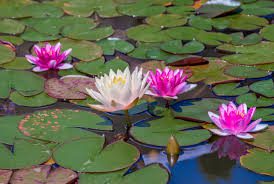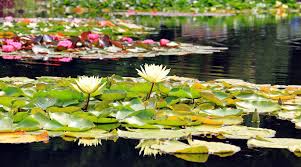Living in a marsh environment is a tradeoff for plants. On the one hand, they are protected from drought and extreme temperature variation, and they enjoy an abundant nutrient source. On the other hand, light may be inadequate, oxygen may be scarce at night, and reproduction must be modified.
Despite these disadvantages, aquatic plants are so well adapted to this habitat that most are found only where there is water. This section looks at the unique strategies of aquatic plants for photosynthesis, gas exchange, support, and reproduction.
1. Photosynthesis
Sunlight available to submergent (underwater) plants is often limited, especially in a marsh with a high plankton density, such as the enhancement marshes.
Many submergent plants have extra chloroplasts in the outer cell layers of their leaves and stems. In contrast, terrestrial
plants protect their chloroplasts with a cuticle, since strong sunlight can harm chloroplasts.
2. Gas Exchange and Support
Common to almost all aquatic plants is air passages and special leaf structure. In emergent plants (those rooted in shallow water), large air passages transport oxygen from the stems and leaves to waterlogged roots. These passages give the plants strong, erect stems and leaves.
In floating-leaf plants, such as water lilies, air chambers in both the stems and the leaves provide buoyancy. Also, whereas terrestrial plants have stomata¼s on the undersides of their leaves, floating leaves have them only on the upper side.
Read Also: Aquatic Environment, Classes of Aquatic Organisms and its Limiting Factors
In submergent plants, air passages not only provide buoyancy but also allow for oxygen storage, to supply oxygen at night. Since submergent plants must obtain oxygen from the water, their leaves are very thin and extensively partitioned, allowing for gas exchange directly through the cell walls.
Water marigold has this type of leaf below the surface, but the leaves above water exchange gases through stomata’s. Reproduction and Winter Survival: A variety of reproductive strategies are found among aquatic plants.
In many cases, plants reproduce vegetatively some or all of the time. Some plants are perennial. Those that reproduce asexually often capitalise on the water for pollination and/or seed dispersal.
Even among submergent plants, pollination and seed dispersal usually take place above the water’s surface. Wild celery produces male and female flowers. The female flowers are suspended on long stalks extending to the surface.
Male flowers develop underwater, float to the surface, open, and drift until they contact a female flower. The female flower is pollinated and then coils down into the water, where the seeds develop.
Cattails, with their familiar “cigar heads” full of seeds, have male and female flowers. Wind carries pollen from the male to the female flowers. After the seeds develop, the water transports them until they settle in a suitable location.
Many aquatic plants use vegetative reproduction some or all of the time. Cattail, pondweed, and water lilies all produce thick rhizomes which serve for both reproduction and food storage. Arrowhead produces tubers, popularly called duck potatoes. The tubers survive over the winter and produce new plants in the spring.
Still other plants use over wintering strategies to survive from one year to the next. Duckweed is one example; this plant rarely produces seeds. As winter approaches, duckweed produces small fronds with undeveloped roots.
They accumulate starch reserves, sink to the bottom under their own weight, and remain there throughout the winter. In the spring, as starch is used up in respiration, air spaces develop in the tissues, and the fronds become lighter and float to the surface.
Read Also: Metabolic Wastes Complete Management Guide
3. Freshwater Zonation

There is a pattern where freshwater plants can grow. Whereas some are found in only the shallowest water, others survive in deeper water. Because depth controls where plants grow, they form zones. Herbaceous plants are categorised according to their position relative to the water.
Emergent plants (cattails, bulrushes, and sedges), grow close to the shore. Rooted in muddy soil or shallow water, they send up tough, rigid stalks and leave as much as six feet above the surface.
Floating-leaf plants (marsh pennywort, lilies, and spatterdock) are rooted underwater. Their flexible, air-filled stems support broad leaves that float on the surface. Since the stems may be several feet long, these plants survive in deeper water than emergent plants.
Submergent plants (widgeon grass, milfoil, and coontail), with weak stems and feathery leaves, grow completely underwater. Thus, they can grow in still deeper water, provided it is clear enough for light to penetrate.
Free-floating plants (duckweed) float on the surface and are not limited by depth. Their dangling roots obtain nutrients from the water. These tiny plants multiply rapidly and form a bright green mat on the water’s surface.
Because each type of plant is limited to a range of depth, the plants form zones. The deeper water supports only free-floating and submergent plants, floating-leaf plants grow in somewhat shallower water, and emergent plants are restricted to the shallow perimeter. Although unseen, phytoplankton is a significant marsh producer limited only by the availability of sunlight.
Zonation, or the pattern of growth according to depth, is visible in the enhancement marshes. Because of the shallow depths of the enhancement marshes (typically 1 1/2 to 3 feet), zones are less pronounced than they would be in deeper ponds. The following should be noted about aquatic plants:
• Emergent plants grow only in the shallowest water,
• Floating attached plants are limited by the length, to which their stems can grow,
• Submergent plants are limited by the penetration of light through the water;
Floating unattached plants are relatively unrestricted by depth.
4. Succession
Succession, the series of replacements of one community by another, occurs in a pond or marsh as organisms die and fall to the bottom. Gradually it fills in and becomes shallower, sometimes over thousands of years.
Species previously excluded by depth are able to colonise. The presence of a substantial amount of emergent vegetation marks the transition from pond to marsh. Eventually the marsh dries and is taken over by grasses, then moisture-tolerant woody species (willows and alders), and eventually, hardwoods and conifers.
The stages of succession are reflected by the pattern of zonation from open water to dry land. Imagine starting at the center of the marsh and travelling outward. The progression can be seen as a travel through time, from pond community to more advanced successional communities.
With regard to succession, the enhancement marshes are different from natural marshes in that they are manipulated, through routine harvesting, to retain their marsh characteristics (i.e. prevent succession). Nevertheless, it is important to know that visible stages of succession are a reminder that ecosystems are continually changing.
Read Also: Features for Adaptation of Fish Aquatic Environment

